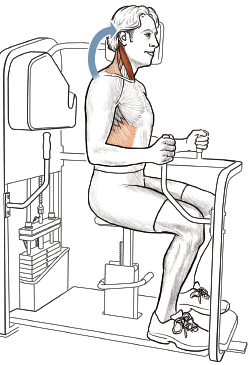CHAPTER 3 Shoulders and Neck
The shoulders are continuously strained while you ride. As the primary link between your upper extremities and torso, the shoulder constantly supports the weight of your upper body. Regardless of your position on the bike—standing, sitting, or sprinting—your shoulders fight the force of gravity. At other times, such as during a steep climb or sprint, you’ll be pulling hard on the handlebars. This chapter will help you train for all these stressors.
Your deltoid is the primary muscle involved in the powerful movements of the shoulder, and each exercise will focus on a different functional section. This chapter also gives you specific exercises to work your rotator cuff. Rotator cuff seems to be a popular term among athletes, and this chapter will help you better understand this group of muscles. The primary role of the rotator cuff is stabilization of the shoulder joint. Many athletes fail to spend time specifically conditioning this important set of muscles. Since the rotator cuff is not as visible as the deltoid, this group of muscles is often forgotten while training in the gym. This is a mistake that can lead to serious shoulder pain and injury.
Your neck also has a tough task when you’re on the bike. Whether you’re riding on the hoods, tops, or drops of your handlebars, your neck will spend the majority of your ride in an extended position. This will strain the splenius and other neck extensor muscles. In this chapter, you’ll find multiple exercises to address this cycling stressor. As previously mentioned, you should train to maintain proper symmetry and balance. To help protect your spinal alignment, this chapter also provides exercises for training the primary neck flexor—the sternocleidomastoid.
I’ve worked with numerous athletes who have developed neck problems. The causes can be multifactorial, but the two most common culprits are overtraining and poor position on the bike. You should take your time advancing your training program. When you’re ramping up your riding volume, include plenty of recovery days to give your body time to adjust. Neck pain and neck problems can be completely debilitating, and working to avoid injury is your best option. By spending time in the gym strengthening your neck, you’ll be better prepared for the ongoing strain placed on your neck during training.
Since your shoulders and neck are taxed during your entire ride, proper position is of the utmost importance. If you are too far forward or your handlebars are too low, you may develop early fatigue and face possible injury. There is always a tradeoff between comfort and performance (or aerodynamics) when determining your best fit. Spend time fine-tuning your position before you start training. If you are concerned about your fit, visit your local bicycle retailer or bike club to find a bike fitter. Paying for a professional bike fit is often money well spent.
Even if you train properly and your form is perfect, the very nature of the cycling position will eventually start to strain your neck and shoulders. The bent-forward, head-up position will gradually lead to imbalances in your neck and shoulder musculature. After years of riding, your cervical curve will accentuate, and the intervertebral spaces will narrow posteriorly. Because your arms are extended to the bars and your thoracic spine is bent forward, your scapulae will rotate forward and downward. This will start to strain the muscles stabilizing your shoulder joint. You must work to counter these changes as you train and progress in your cycling career. This chapter will help you train not only your primary cycling muscles, but also the counterbalancing muscles that will help prevent these detrimental changes.
Shoulder Joint
The shoulder is a complicated ball-and-socket joint formed by the proximal end of the humerus and the scapula. Similar to the other ball-and-socket joint—the hip—the structure of the shoulder allows a large degree of mobility. The shoulder allows six primary movements:
Flexion: Elevating your arm in front of you toward your head
Extension: Elevating your arm behind you toward your head
Adduction: Moving your arm inward toward the side of your body
Abduction: Moving your arm outward, away from the side of your body
Internal rotation: Turning your arm and palm downward
External rotation: Turning your arm and palm upward
With high mobility also comes greater potential for injury. The more freedom of movement allowed at a joint, the less fixed support holding the joint in place. This highlights the importance of having a strong and well-conditioned shoulder joint.
Deltoid
As previously discussed, the muscular structure of your shoulder provides a wide range of movement. As a key player in your shoulder movement, the deltoid is a highly developed muscle. The three heads of the deltoid (anterior, lateral, and posterior) combine into a single tendon that inserts onto the humerus (see figure 3.1). The anterior deltoid originates on the clavicle and primarily performs shoulder flexion. The lateral (middle section) deltoid attaches to the acromion and abducts the arm. The posterior (rear) deltoid originates on the scapula and provides shoulder extension. Although there is crossover, this chapter provides specific exercises that focus on each of the three sections of the deltoid.

Figure 3.1 Deltoid muscle.
Rotator Cuff
The rotator cuff is a group of shoulder muscles that form a stabilizing and protective shell around the shoulder joint (see figure 3.2). Although they are small in size, these muscles are vital to proper shoulder function. The rotator cuff is composed of four muscles that all attach to various areas of the scapula. The subscapularis is located in the front of the scapula, and the primary role of this muscle is to rotate the arm inward. Behind the scapula lies the infraspinatus muscle and the teres minor. Both of these muscles rotate the arm outward. Finally, the supraspinatus lies on the superior aspect of the scapula. This muscle abducts the shoulder (lifts the arm away from the body) and also rotates the shoulder outward.
Neck Musculature
The neck is a highly mobile and fairly fragile section of the spine. Numerous muscles and ligaments work together to provide this high degree of movement while simultaneously providing adequate stabilization. In this book, we’ll focus on the primary movement muscles. The splenius extends the neck (see figure 3.2). It runs along the upper spine and connects to the base of the skull. The trapezius (covered in chapter 5), the levator scapula, and the posterior portion of the sternocleidomastoid all cooperate to aid the splenius in neck extension. Adequate training of all these muscles is vital to your riding health.
The sternocleidomastoid performs front and lateral flexion of the neck and is divided into the sternal head and the clavicular head. As indicated by its name, this muscle connects to the sternum, clavicle, and mastoid of the skull. Long hours on the bike can overemphasize the splenius, and you may find yourself with an underdeveloped sternocleidomastoid. This can potentially cause undue strain on your cervical spine, resulting in pain and disc injury

Figure 3.2 Muscles of the rotator cuff and neck.
.
Warm-Up and Stretching
Spend 10 minutes warming up the muscles of your neck and shoulders. Jumping rope and rowing on a machine are excellent cardio warm-ups for the exercises in this chapter. After you have the blood moving and the pores open, you should take time to adequately stretch. Your neck and shoulders can be easily injured if you jump into the exercises without a proper warm-up. Shoulder rotations forward and backward, as well as individual stretches, will ensure that your entire joint is loose. The shoulder can rotate through 360 degrees, so make sure you move through your entire range of motion. After stretching the neck forward, backward, and side to side, you can perform some simple isometric exercises to ensure that the neck muscles are ready for your workout. Simply hold your hand against your head to offer resistance to movement. For 10 to 15 seconds, work each group of muscles against the resistance.
Dumbbell Shoulder Press
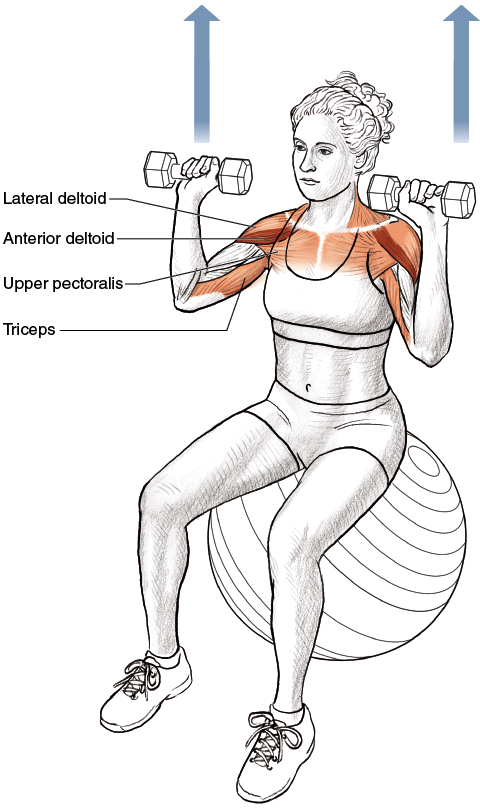

Safety Tip
Be careful that the ball doesn’t roll backward when you are performing this exercise. While keeping your back straight, make sure that your weight and buttocks are slightly forward on the stability ball.
Execution
1. Sit on a stability ball and hold the dumbbells with your arms bent and your hands at shoulder level. Your palms should be facing forward.
2. Raise the dumbbells vertically together until your elbows are straight.
3. Lower the dumbbells together back to the starting position.
Muscles Involved
Primary: Anterior deltoid
Secondary: Lateral deltoid, triceps, upper pectoralis, trapezius
Cycling Focus
As mentioned in the introduction to this chapter, the shoulder is constantly under pressure while you are on your bike. Every cycling position relies on the shoulder to counter the weight of the torso as it leans forward on the handlebars. The shoulder press is fundamental to strengthening both your anterior and lateral deltoid. These muscles are key in stabilizing your torso as you pedal. Many cyclists sway from side to side as they ride. Remember that any movement of the bicycle that does not contribute to the forward motion is wasted and should be minimized. Rocking the bike from side to side dissipates energy that could have contributed to the propulsion of your bike.

Variations
Machine Shoulder Press
The machine offers added safety and stability. If you feel nervous about doing the shoulder press with dumbbells or a barbell, the machine is an excellent option.
Barbell Shoulder Press
You can do the same exercise using a barbell. This variation has two options for starting positions. With your hands shoulder-width apart, place the bar across your upper chest or behind your head on your upper back. Raise the barbell above your head until your elbows are straight. Return to the starting position and repeat.

Upright Row
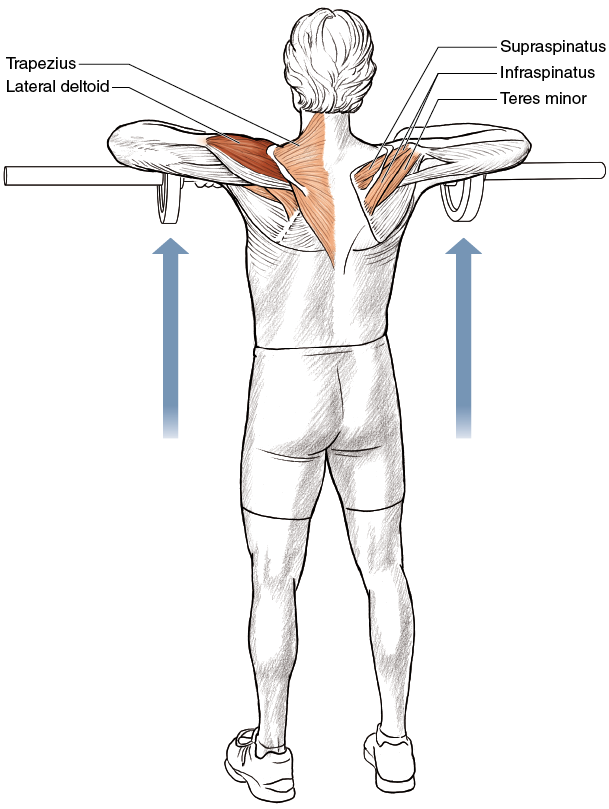
Execution
1. Hold the barbell with your arms extended down. Use a palm-down grip with your hands positioned slightly narrower than shoulder-width apart.
2. Pull your hands vertically upward to your upper chest, keeping your elbows high.
3. Slowly return to the starting position.
Muscles Involved
Primary: Anterior deltoid, lateral deltoid
Secondary: Infraspinatus, supraspinatus, teres minor, trapezius
Cycling Focus

During a longer climb, you’ll likely find your hands resting on the top of the handlebars. If you decide to really hammer your way up the mountain, you’ll pull upward on the bar with each turn of the cranks. Watch any climber during a mountainous stage of the Tour de France and you’ll see that this is the position the rider assumes once he gets into his climbing rhythm. You should focus on this position while you perform the upright row. This exercise prepares you for your future climbing efforts by strengthening the deltoid, arm, and grip. If you stand and climb with your hands on the hoods—as many riders do when they decide to surge—you’ll rely on the muscles trained in this exercise.

Variations
Cable Upright Row
You can also use a pulley machine to effectively perform the upright row. Use a straight-handle attachment on a low pulley. Keeping your back straight and your elbows high, pull your hands vertically to your upper chest.
Upright Row on Stability Disks
This is an excellent exercise for using the stability disks. Using stability disks will not only force your lower legs to stabilize your position, but will also train your lower back and torso.
Dumbbell Raise and Sweep

Execution
1. Hold a dumbbell in each hand using a palm-down grip. Your elbows should be extended, and your arms should be at your sides.
2. Keeping both your arms straight at the elbows, lift your right arm upward in front of you until it is parallel with the floor. Simultaneously, lift your left arm upward to the side until it is also parallel with the floor.
3. In the horizontal plane, swap your arm positions. Move your right arm out laterally to your side, and move your left arm straight out in front of you.
4. Lower the dumbbells back to your sides. Repeat the exercise again, alternating the starting position.
Muscles Involved
Primary: Lateral deltoid, anterior deltoid
Secondary: Trapezius, upper pectoralis, posterior deltoid, supraspinatus, erector spinae, torso
Cycling Focus
This is a great exercise for cyclists. It simultaneously works multiple aspects of the shoulder and the core. When you are climbing out of the saddle, you’re constantly shifting your weight from side to side to deliver the most power to the pedals. (A similar movement is used when attacking on the flats or sprinting for a finish.) This shifting repeatedly torques your upper body and stresses your shoulder joints. By simulating this movement with both lateral and anterior stressors concurrently, the dumbbell raise and sweep forces your back and torso to fight to keep your upper body from moving. During this exercise, your center of gravity is dynamically shifted, and you have to compensate. Not only will your deltoids get a great workout, but you’ll also be adding to your core stability training.

Variation
Dumbbell raise and sweep on stability disks: Consider using stability disks to really torture yourself during this exercise.
A-Frame


Finish position.
Execution
1. Hold the dumbbells with your thumbs up, your elbows at your waist, and your forearms in front of you.
2. Sweep each dumbbell laterally while keeping your forearms parallel with the floor.
3. Keeping your elbows locked at 90 degrees, lift the dumbbells up above your head until they touch.
4. Lower the dumbbells back to the lateral position and then sweep them forward, reversing the motion you previously performed.
Muscles Involved
Primary: Lateral deltoid, subscapularis, infraspinatus, supraspinatus, teres minor
Secondary: Anterior deltoid, posterior deltoid, trapezius, biceps
Cycling Focus

The rotational movement of this exercise specifically targets the rotator cuff. Although cyclists don’t often think about training their rotator cuff, its muscles are vitally important for almost every athlete. When you’re in your riding position, the rotator cuff locks the shoulder into place, giving you a platform on which to support your body weight. This is fundamental to a stable shoulder, and if you have a weak or underdeveloped rotator cuff, the constant forces that riding places on your shoulder will cause pain and discomfort. Cyclists who have sustained a rotator cuff injury during a crash can attest to how much discomfort they have when trying to rehabilitate on their bicycle.
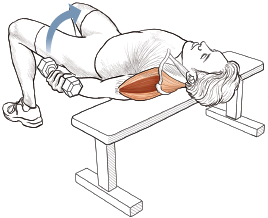
Dumbbell internal rotation. Dumbbell external rotation.
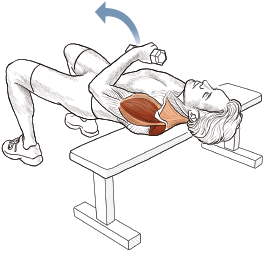
Variations
Dumbbell External Rotation
Lie with your back and elbow resting on a bench. Holding a dumbbell, lay your forearm across your waist so it is parallel to the floor. Keeping your upper arm in tight to your body, rotate your shoulder so that your forearm moves in an arching motion from your waist to a vertical position. Return to the starting position.
Dumbbell Internal Rotation
Lie with your back and elbow resting on a bench. Holding a dumbbell, lay your forearm out to the side so it is parallel with the floor or the bench. Keeping your upper arm in tight to your body, rotate your shoulder so that your forearm moves in an arching motion from the bench to a vertical position.
Note: You can combine the external and internal rotation exercise and complete an entire 180-degree sweep with your arm.
Stability Ball Dumbbell Raise

Execution
1. Place your feet against a wall and rest the front of your hips and abdomen on a large stability ball.
2. Hold a dumbbell in each hand and let your arms hang vertically downward toward the floor. Your thumbs should be facing upward.
3. Keeping your elbows straight, raise your hands in an arching motion until they are at 90 degrees to each side and parallel with the floor.
4. Return to the starting position.
Muscles Involved
Primary: Posterior deltoid
Secondary: Lateral deltoid, trapezius, rhomboid, infraspinatus, teres minor, teres major, erector spinae
Cycling Focus

Essentially, two forces are placed on your arms and shoulders while you are riding. The first is the constant downward force placed on the bars by your body weight and body position. The second is the upward pull of your arms on the bars when you are sprinting or climbing. The bent-over dumbbell raise focuses on the muscles used in the latter and develops the posterior aspect of your shoulder. Because most of your time on the bike is spent leaning forward, much of the shoulder development that occurs while riding will be to your anterior shoulder. That is why this gym exercise is so important. Remember that your body is designed for symmetry. To balance the anterior muscle development, you will need to focus on this exercise to train your posterior shoulder. This will help properly align your shoulder joint and prevent aggravating injuries.

Variation
Bent-Over Dumbbell Raise on Bench
If you feel unstable on the stability ball or it puts too much strain on your back, you can perform this same exercise sitting on a bench. Bend over so your chest is nearly resting on your knees. Keep your elbows straight and your arms down at your sides. Slowly raise your arms out to each side until they are parallel with the floor.
Single-Arm Dumbbell Row

Execution
1. Rest your knee and same-side hand on the bench. Keep your back parallel with the floor.
2. Hold a dumbbell in your opposite hand and let your arm hang vertically toward the floor.
3. Bring your hand upward until your hand reaches your chest. Your elbow should brush against your side as your arm moves upward.
4. Return to the starting position.
Muscles Involved
Primary: Posterior deltoid, latissimus dorsi
Secondary: Trapezius, rhomboid, biceps
Cycling Focus

In the illustration of this exercise, you can see its similarity to the cycling position. While doing this exercise in the gym, you should think about sprinting powerfully on your bike. When you stand up to sprint, you’ll not only be crashing down on the pedals, but you’ll also perform huge pulls on the bars with your arms. The single-arm dumbbell row will simulate this surging pull of your arms and help you get every ounce of energy out of your sprint. When doing the exercise, imagine yourself in a sprint finish, fighting for the victory. Try to feel each arm pulling on the handlebar as your muscles scream under the strain.

Variation
Single-Arm Cable Pull
Sitting on a bench or stability ball, hold the handle for the low pulley with one hand. Place your other hand on your knee for stability. Let your arm fully extend in front of you. Pull your hand back to your side, keeping your elbow and arm tight to your body.
Floor Bridge
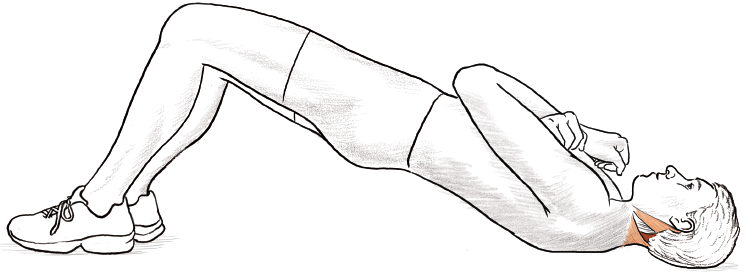
Execution
1. Lie on the floor on your back. Pull your feet up toward your buttocks, and cross your arms on your chest.
2. By looking upward and behind you, slowly extend your neck back, lifting your shoulders and body off the floor. Keep your back straight.
3. Slowly roll your neck forward, returning to the starting position.
Muscles Involved

Primary: Splenius capitis
Secondary: Trapezius, levator scapula, erector spinae, posterior sternocleidomastoid
Cycling Focus
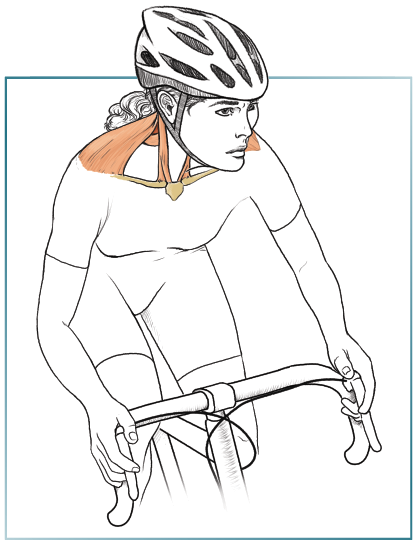
This is a fundamental exercise for a healthy neck, especially when you spend a lot of time on your bike. The majority of your riding time will be spent with your neck in extension. If you take time off from the bike and then start riding again, you may often find that your neck is the sorest part of your body. A strong neck will help maintain proper spinal alignment and help prevent problems in the future. When you initially perform this exercise, you must be sure not to overdo it. You may feel great while in the gym, but soreness will often creep up on you the next day. A few years back in the Race Across America, a competitor’s neck became so fatigued from the constant extension that he couldn’t even look up. His mechanic had to do some improvisation. He devised a support splint connected to the rider’s shoulders and helmet that held his head upright so he could see where he was going!
Safety tip
Make sure you are well stretched before doing this exercise. You must also ensure that you don’t overextend your neck. Avoid arching your neck so that the weight is resting on the top of your head.
Neck Extender
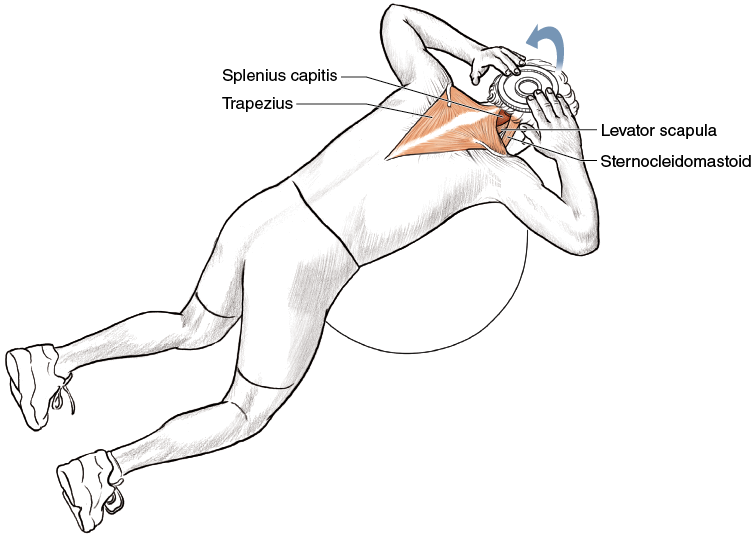
Execution
1. Kneel beside a stability ball. Lean your chest on the ball and hold a weight plate on the back of your head.
2. Start with your neck flexed forward. Slowly extend your neck and raise your head until you are mimicking the neck position you use while riding.
3. Return to the starting position.
Muscles Involved
Primary: Splenius capitis
Secondary: Trapezius, levator scapula, erector spinae, posterior sternocleidomastoid
Cycling Focus
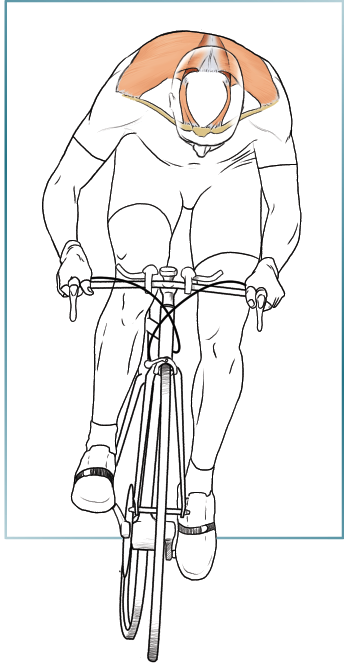
Because the neck extenders are so challenged while you are riding, I’ve included two exercises that focus on these muscles specifically. Think about the extreme neck extension needed when in an aerodynamic time-trialing position. Although you may never need to time trial, almost every riding position forces your neck to hold your head up so you can see the road. This exercise is excellent at mimicking this position and really focuses on the muscles used while riding. With all the neck exercises, you must remember to start with lower weights and work your way up. The point of the exercise is to help you avoid injury on your bike, so don’t hurt yourself while working out in the gym!
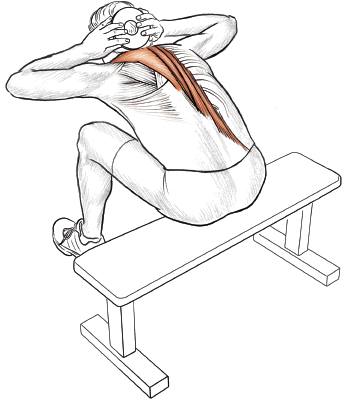
Variation
Neck Extender on Bench
If leaning over on the stability ball is difficult on your back or knees, you can perform this same exercise while sitting on a bench. This will offer more stability while still focusing on the same muscles.
Neck Flexor

Execution
1. Lie with your shoulder blades resting on the stability ball. Hold a weight plate with both hands on your forehead.
2. Start with your neck extended (head back). Slowly flex your neck and raise your head upward, chin toward your chest.
3. Return to the starting position.
Muscles Involved
Primary: Sternocleidomastoid
Secondary: Rectus abdominis, external oblique, internal oblique
Cycling Focus

As mentioned, good health and fitness are all about balance. Because cycling places such a strain on your neck extenders, these muscles can become more developed than your sternocleidomastoid. If this occurs, the neck extenders can unduly stress the posterior aspect of your spine and cause asymmetry. Over time, this asymmetry can misalign your spine and cause pain. A well-known cyclist and friend of mine had to completely stop cycling in his 50s because his neck caused him so much pain. After six months of physical therapy—balancing his neck and back muscles—he was back on the bike and riding pain free.

Variation
Wall Neck Flexor
A simple variation of the neck flexor exercise can be done almost anywhere. Lean forward and place your forehead against a wall (you may use a pad for comfort). Flex your neck so your eyes look toward the floor. Return to the starting position.
Side Neck Lift

Execution
1. Lie on your side with one arm draped over the stability ball. Hold a small weight plate with your opposite hand against the side of your head.
2. Start with your downward-facing ear near your shoulder. Keep your eyes looking forward, and laterally flex your neck until your upward ear is nearly touching your shoulder.
3. Return to the starting position. Repeat, switching sides.
Muscles Involved
Primary: Sternocleidomastoid
Secondary: Splenius capitis, erector spinae, levator scapula, trapezius, external oblique, internal oblique
Cycling Focus

The sternocleidomastoid allows you to look back to check your opposition while racing. The primary focus of the side neck lift is to help you develop neck stability. More important, this exercise will help keep your spine properly aligned. The vertebral foramen is the passage in the middle of your vertebrae. Through this space, the spinal cord courses down your spine, protected from injury or damage. Poor spinal alignment can cause one or more of the vertebrae to impinge on this space, which will cause significant pain as well as potential functional deficits.
Variation
Machine Lateral Neck Flexion
For all the neck exercises, you may choose to use a machine. Lever machines are easy to use, and they provide you with extra stability while performing an exercise.
